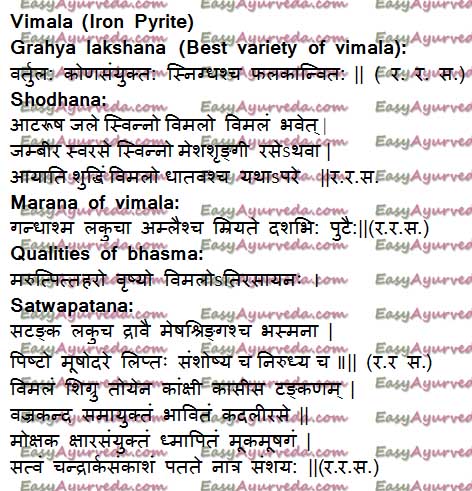Vimala (Iron Pyrite) Shodhana, Marana, Satvapatana
Table of Contents
Introduction, availability, types
Vimala is the 4th maharasa as explained in the text Rasa Ratna Samuchaya. This has been mentioned for the 1st time by the text Rasarnava in the 10th century.
Vimala is the 4th maharasa as explained in the text Rasa Ratna Samuchaya. This has been mentioned for the 1st time by the text Rasarnava in the 10th century.
This is available in the mines of Bihar, Orissa and Madhya Pradesh.
Chemical formula: Fe2S3
Chemical composition: Iron and Sulphur
Hardness: 6.2
Types:
There are 3 types of Vimala namely –
Hema vimala – Is golden colored, light in weight and the best variety
Roupya vimala – Is silver colored and light in weight
Kamsya vimala – Is bronze colored
Selection crieteria
Grahya lakshana (Best variety of vimala):
The best variety of vimala is circular, with angles, shining, and with clear-cut surfaces.
Purification
Shodhana:
A. Pieces of vimala are taken in a pottali and swedana is given with vasa patra rasa (Adhatoda vasica) for 3 hours.
B. Pieces of vimala are taken in a pottali and swedana is given with lemon juice or meshashringi rasa (Gymnema sylvestre) for 3 hours.
After the process of shodhana, vimala is subjected for the process of marana so that it can be converted to bhasma form.
Classical reference

Marana of vimala:
Vimala is made into fine powder in a khalva yantra and mixed with equal amount of purified sulphur.
Then trituration is done using lakucha rasa and the mixture is made into small cakes. After drying the cakes it is subjected to gaja puta. The entire process is repeated for 10 times. The final bhasma will be red in color.
Qualities of purified vimala
Guna of bhasma:
The bhasma of vimala mitigates Vata and Pitta dosha, it is Vrushya and Rasayana.
It is used to treat grahani, pandu and udara roga.
Dose: ½ to 2 ratti (65 mg to 250 mg)
Satwapatana:
A. Vimala powder is mixed with equal parts of Tankana and Meshashrungi Bhasma, triturated with Nimbu swarasa and lakucha swarasa, made into a bolus and subjected to intense heat in a Musha to get its satwa.
B.The fine powder of vimala is mixed with equal amount of kamkshi, kaseesa, tankana and vajra kanda and triturated with the decoction of drumstick tree bark. Later equal amount of mokha khsara is added to vimala and triturated with banana stem juice and subjected to moosha to obtain white colored satwa from vimala.
Studies on vimala
Research articles related to Vimal:
Comparative Pharmaceutico- analytical study of vimala bhasma:
The objective of the study was preparation and analytical study of Vimala bhasma prepared by classical puta method and electrical furnace method. (1)
Characterization of different samples of makshika and Bimala:
Metals and minerals collected from different ores were subjected for chemical analysis to find the elements present in them. (2)
Important formulations containing Bimal:
Rasendra Choodamani Rasa
Ksyakesari rasa
Sheegra prabhava rasa
Paradadi pralepa
Madana sanjeevana rasa
Author:
Dr.B.K.Prashanth
M.D (Ayu), Ph.D
E mail: [email protected]
Click to consult Dr. Prashanth B.K








